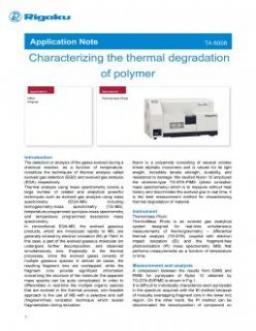The detection or analysis of the gases evolved during a chemical reaction, as a function of temperature, constitute the techniques of thermal analysis called evolved gas detection (EGD) and evolved gas analysis (EGA), respectively.
Thermal analysis using mass spectrometry covers a large number of related and analytical powerful techniques such as evolved gas analysis using mass spectrometry (EGA-MA) including termogavimetry-mass spectrometry (TG-MS), temperature programmed pyrolysis-mass spectrometry and temperature programmed desorption mass spectrometry.
In conventional EGA-MS, the evolved gaseous products, which are introduced rapidly to MS, are generally ionized by electron ionization (EI) at 70eV. In this case, a part of the evolved gaseous molecular ion undergoes further decomposition, and observed simultaneously ions. Especially in the thermal processes, since the evolved gases consists of multiple gaseous species in almost all cases, the resulting fragment ions are overlapped, while the fragment ions provide significant information concerning the structure of the molecule, the apparent mass spectra can be quite complicated. In order to differentiate in real-time the multiple organic species that are evolved in the thermal process, one feasible approach is the use of MS with a selective and soft (fragment-free) ionization technique which avoids fragmentation during ionization.
Nylon is polyamide which including the multiple monomers combined due to amide bond. To study about thermal decomposition of three typical Nylon resins which have similar structure employed the skimmer-type TG-DTA-PIMS, photoionization mass spectrometer, it is available to characterize the evolved gases in real time and to discriminate easily for in each Nylons.
Evolved gas analysis products from Rigaku
In TG-FTIR, gases evolved by volatilization or thermal decomposition are qualitatively analyzed, which allows you to track changes in the generated amount along with the temperature change.


